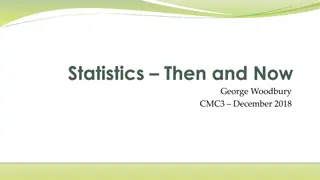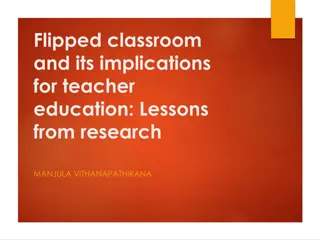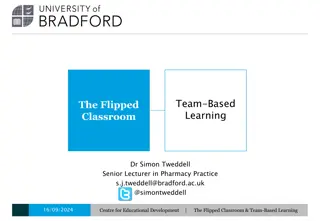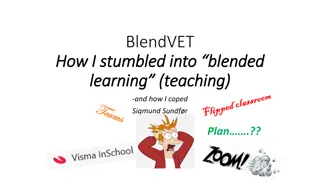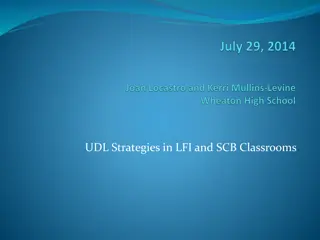Small Group Teaching and Flipped Classrooms
This insightful presentation delves into the framework, advantages, ways to incorporate, and pros and cons of small group teaching and flipped classrooms. It covers topics such as active learner engagement, creating safe learning environments, and the benefits of a flipped classroom approach. The content explores various teaching methods like problem-based learning, case-based learning, team-based learning, and more to enhance student engagement and learning outcomes.
Download Presentation

Please find below an Image/Link to download the presentation.
The content on the website is provided AS IS for your information and personal use only. It may not be sold, licensed, or shared on other websites without obtaining consent from the author.If you encounter any issues during the download, it is possible that the publisher has removed the file from their server.
You are allowed to download the files provided on this website for personal or commercial use, subject to the condition that they are used lawfully. All files are the property of their respective owners.
The content on the website is provided AS IS for your information and personal use only. It may not be sold, licensed, or shared on other websites without obtaining consent from the author.
E N D
Presentation Transcript
Small Group Teaching Danielle Castagneri, MD
Objectives - To create a framework for small group teaching To establish pros and cons of small group teaching and flipped classrooms To learn and practice techniques to increase engagement in small group learning - -
Advantages of teaching in small groups - Encourages active learner engagement - Promotes an open and safe learning environment - Promotes community bonding within a residency
Ways to incorporate small group teaching - - - - - - - Pause Procedures Flipped classroom Problem-Based Learning Case-Based learning Team-Based learning Ethics discussions Simulation
What is a flipped classroom? Example: - Learners pre-view materials that might formerly have been used as didactic lecture, and use class time to engage in student-centered learning activities - Pre-class preparation may include a brief 15-20 minute video lecture, podcast, or textbook reading During class, students may take a brief (5 minute) formative quiz to gauge understanding Questions and misconceptions may briefly be addressed (5-15 minutes) Students use the remainder to engage in discussion, problem-solving, or performance to apply the skills learned - - - (Moraros et a, 2015)
Pros and cons: Flipped Classroom and Small Groups PRO - - Increased engagement Adult learners tend to prefer flipped classrooms and small groups over didactic lectures (Moraros et al 2015) Promotes long term retention Allows for the practice of clinical applications (King et al 2017) Flexibility of content Promotes higher level cognitive skills - - - -
Pros and cons: Flipped Classroom and Small Groups CON Increased time requirements from both instructors and learners Increased staffing requirement (higher learner-to-facilitator ratio) Difficulties in ensuring learner accountability if preparation is required Technology integration Burden of lesson planning can be higher - - - - -
General best practices - - Prioritize active learning in small groups Rapid-fire case discussions with targeted learning points have been highly rated by students (King et al 2017) Incorporate pause procedures to allow for internal active processing Consider allowing open (self-chosen) resources for pre-class preparation for adult learners Keep pre-meeting preparation materials short (<20 minutes) The learners should lead, not the facilitator Exemplar Resources: Podcasts and video lectures - LITFL - EmCrit - EM Cases - EKG Weekly - CORDem - SonoSpot - The POCUS Atlas - 5-minute Sono Textbooks (Tintinalli, Rosen) - - - - - -
Pitfalls - Is this truly a flipped classroom or just a lecture with pre-reading? Avoid the double lecture mistake How to assess success? ITE may not be sensitive enough a tool (King et al 2017) Inadequate time to prepare-- for residents AND facilitators HINT: Multimedia choices for preparation such as podcasts, video lecture, or a multimedia textbook that required less than <30 min to complete increased compliance with prework (King et al 2017) - - -
Practice We will apply the knowledge obtained from our pre-reading to practice writing our own learning objectives and example lesson planning prompts for a different topic chosen by the group. The following examples are from: Not Another Boring Lecture: Engaging Learners with Active Learning Techniques Wolff, Margaret et al. Journal of Emergency Medicine, Volume 48, Issue 1, 85 -93 (Prereading)
Example topics - - - - - - - - Advanced airway techniques Advanced cardiac ultrasound Empiric antibiotic coverage in immunocompromised patients Building differential diagnosis for X chief complaint Ethics topics EKG review Case-based: Choosing RSI medications for specific indications Journal Club
Think-Pair-Share After a discussion of the management of febrile neonates with fever: - THINK: ask the group to silently choose an antibiotic regimen for a febrile neonate. PAIR: instruct learners to pair with a neighbor to discuss answers SHARE: instructor randomly calls on pairs to share with the group. Allows learners who may be unwilling to speak up in larger groups to practice answers and come to a consensus in a safe learning environment - - Examples from: Not Another Boring Lecture: Engaging Learners with Active Learning Techniques Wolff, Margaret et al. Journal of Emergency Medicine, Volume 48, Issue 1, 85 -93
One-minute paper Example: After a discussion of the management of febrile neonates with fever, ask learners to list microorganisms implicated in neonatal infections Pause procedure that allows for private processing
Commitment activities After a discussion of the management of febrile neonates, ask learners to choose an appropriate antibiotic regimen from a list of choices and text their response using Poll everywhere. Review as a group. Allows for active engagement and formative assessment of learner understanding - Anonymous web-based reporting has higher engagement than identified reporting (Wolff et al) Multiple free modalities allow for free-response answers, which may lead to richer discussion -
Team Based Learning - An obvious application: Simulation Lab After completing prework, learners apply their knowledge in a clinical setting with hands-on simulation Exemplar resources for simulation cases: - https://emsimcases.com/ - https://www.acep.org/tox/sim- cases.html - https://www.healthysimulation.c om/780/emergency-medicine- sim-case-library/ - A common way to conduct a flipped classroom, in which learners complete pre-class preparation and are then challenged to apply core content to scenarios as a team -
Jig Saw A topic is broken into smaller, interrelated pieces and assigned to individual learners. Each learner prepares in advance, and then teaches their portion to their small group. There can then be a performative or summative assessment of understanding A type of cooperative learning that allows learners to become teachers
Exemplars: Problem-based learning - Wolff M, Pomeranz E, Carney M. Febrile young infant learning module. MedEdPORTAL. 2013. Available at: www.mededportal. org/publication/9568. Denson K, ManziG, Crowe C, Rehm J. TBL: navigating delirium, polypharmacy and home care services with an elderly emergency department patient. MedEdPORTAL. 2013. Available at: www. mededportal.org/publication/9599. Koestler J, Waite E, Chietero M, et al. Problem-based learning (PBL): abdominal pain in a pregnant woman. MedEdPORTAL. 2009. Available at: www.mededportal.org/publication/517. Case-based learning in small groups - -
1. Denson K, Manzi G, Crowe C, Rehm J. TBL: navigating delirium, polypharmacy and home care services with an elderly emergency department patient. MedEdPORTAL. 2013. Available at: www.mededportal.org/publication/9599 King AM, Mayer C, Barrie M, Greenberger S, Way DP. Replacing Lectures with Small Groups: The Impact of Flipping the Residency Conference Day. West J Emerg Med. 2018;19(1):11-17. doi:10.5811/westjem.2017.10.35235 https://www.ncbi.nlm.nih.gov/pmc/articles/PMC5785176/ Koestler J, Waite E, Chietero M, et al. Problem-based learning (PBL): abdominal pain in a pregnant woman. MedEdPORTAL. 2009. Available at: www.mededportal.org/publication/517 Moraros J, Islam A, Yu S, Banow R, Schindelka B. Flipping for success: evaluating the effectiveness of a novel teaching approach in a graduate level setting. BMC Med Educ. 2015 Feb 28; 15():27. https://www.ncbi.nlm.nih.gov/pmc/articles/PMC4363198/ Wolff, Margaret et al. Not Another Boring Lecture: Engaging Learners with Active Learning Techniques. Journal of Emergency Medicine, Volume 48, Issue 1, 85 - 93 Wolff M, Pomeranz E, Carney M. Febrile young infant learning module. MedEdPORTAL. 2013. Available at: www.mededportal.org/publication/9568 References 2. 3. 4. 5. 6.





